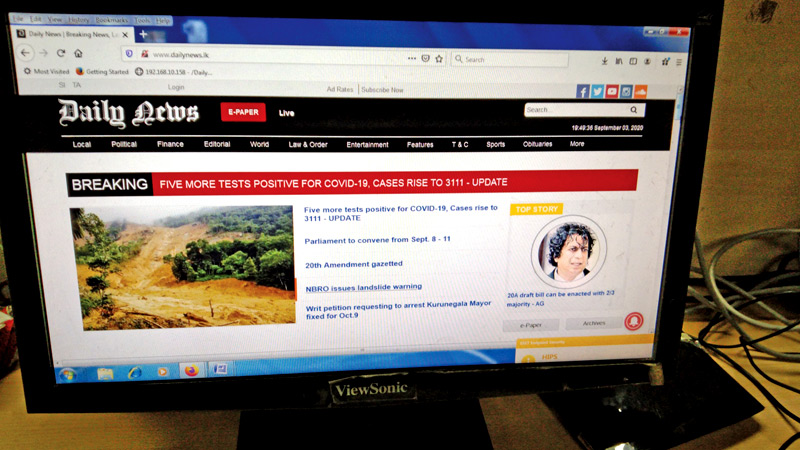Having been forced onetime, under threat of withholding salary increments, to abandon an old, trusty and robust ‘Olympia’ typewriter for a computer, I still struggle to understand how the editorship of Sri Lanka’s first online newspaper was thrust upon me.
Whether due to, `old school ties’ - the then newly appointed benign and soft spoken Chairman Lakshman Jayawardena was an old and senior Thurstanite--(which could be discounted due to my avoidance of anyone wielding power irrespective of whether they used it or not) , or due to the then Production Manager and present General Manager, Abhaya Amaradasa’s ability to talk even the hind leg off a horse or due to some unknown force, the challenge of editing the online edition of the Daily News fell upon me, though strictly speaking I was a member of the Sunday Observer staff back then.
It indeed was a great challenge at the time. WWW or the World Wide Web, http (Hypertext Transfer Protocol), html and other new terminology seemed out of this world to me at least. With one week of training before its launch in 1995, my diffidence dissolved under the guidance of technicians such as D.N. Wijesinghe and T.A.L. Ratnayake. They put me through the paces and burnt the midnight oil assisting in the search for a reader friendly format for the new addition to the Lake House flagship. Bleary eyes greeted a new day with the final selection of the format comprising sections for Business, Features, Editorial, Security, Politics, World, Letters, Sports, Archives and Obituaries, which by and large have survived to this day. They with the all important ‘In Brief’ section would cover the gamut of the newspaper’s contents.
Following the launch at the Galle Face Hotel, the Internet Edition of the flagship was steered by a few dedicated journalists and technicians. Operating from a backroom on the top floor of Lake House overlooking the railway lines leading to and from the Fort Railway Station to the island’s South, they put their shoulders to the wheel with determination.
Starting in the afternoon, all page proofs of the print edition would be accessed, perused, stories selected, sometimes followed up and updated, edited or re-written to cater to a readership of locals, expatriate Sri Lankans and foreigners. Pramod de Silva and Dinesh Weerawansa, who now happen to be the Editors of the Daily News and the Sunday Observer respectively, were among the first young journalists selected to the team. Riza Rawdin of the Daily News, who is now domiciled overseas, came on board a bit later.
Technicians Ratnayake, Jagath Dharmaratna, Nalaka de Silva (the only duo who still work for the Internet section from the original team) and Gerald Nadesan strove to ensure that the publication went ahead without glitches. Punctuality in uploading was paramount to prevent competitors accessing any exclusive stories through the online edition. Theirs was the more onerous job.
Much was achieved by the small team in a small room that became known as the ‘Internet’ and soon the Sunday Observer too went online. It was a moment to be proud of. There was positive and negative feedback. Staffers from a diplomatic mission of an East Asian country, being denied direct access to news from their homeland were profuse with their thanks. Appreciative e-mails (itself fairly new at the time) from around the world including from far off Iceland drove the team to perform at peak as did broken links which failed to mirror stories and sometimes the whole edition. A couple of awards also came their way during the first three months.
Negative feedback mainly related to political stories. They were passed with straight faces on to the then editors of the print editions. A couple of unsuccessful individual attempts were made to divert blame as we strove to maintain credibility. Challenges were accepted and surmounted.
The invaluable assistance rendered by individuals from several departments including the staff of the adjacent Visual Display Terminal (VDT) and Production Department made the venture a success.
They were called upon to and did more than their job. It is a saga that began on a small note, but one that laid the foundation for today’s vast operation that encompasses everything from the E-paper to Facebook and Twitter feeds.
I am indeed proud to have been a member of the original team that made it all possible.


